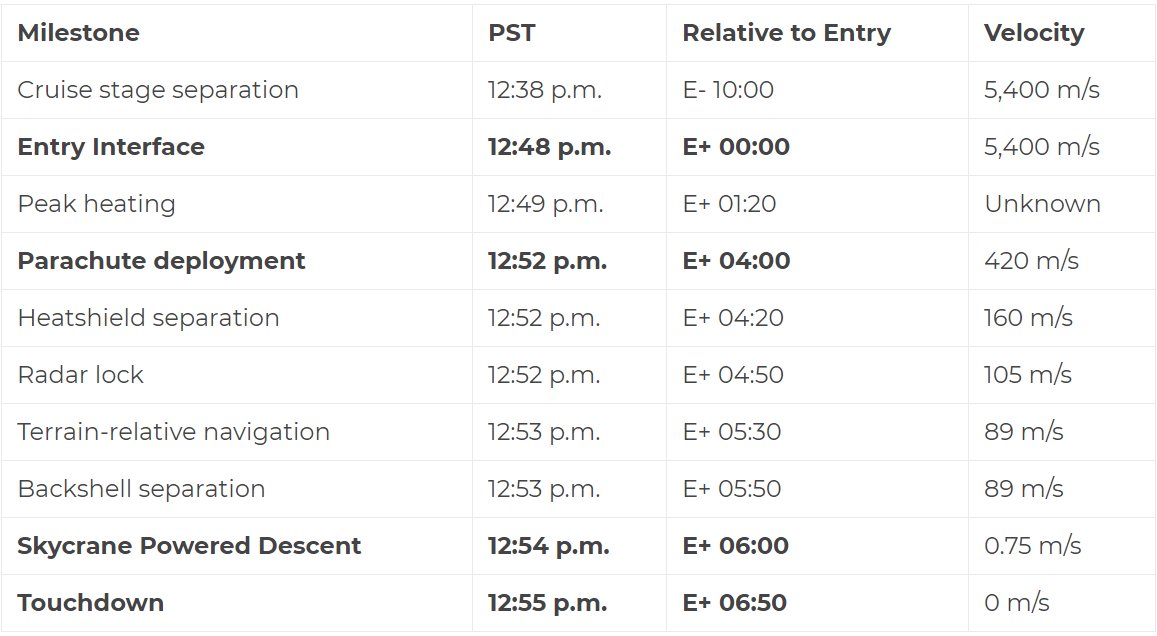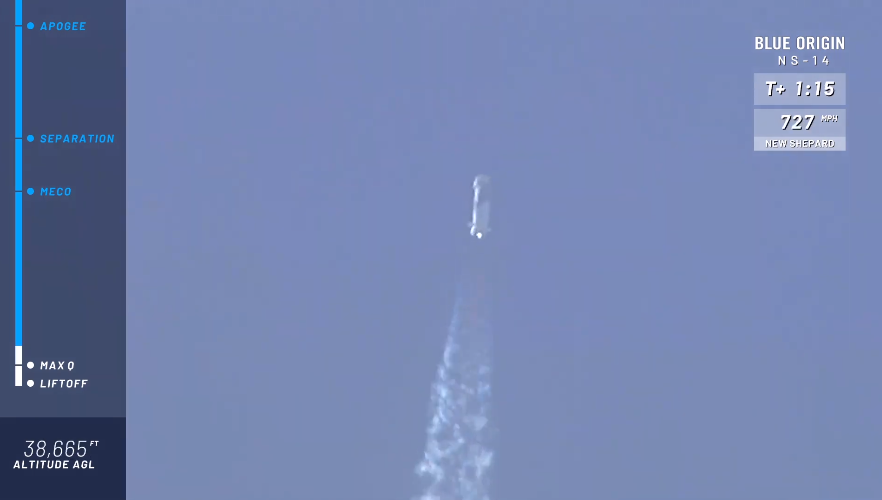
NASA is set to hold a briefing in just 5 minutes on Perseverance's post-landing operations and to unveil the entry, descent, and landing imagery captured for the first time ever.
#CountdownToMars
Watch live:
#CountdownToMars
Watch live:
Participants:
Thomas Zurbuchen, assoc. admin, SMD, HQ
Michael Watkins, dir., JPL
Matt Wallace, Perseverance deputy project manager, JPL
Al Chen, EDL lead, JPL
Dave Gruel, EDL camera lead, JPL
(1/2)
Thomas Zurbuchen, assoc. admin, SMD, HQ
Michael Watkins, dir., JPL
Matt Wallace, Perseverance deputy project manager, JPL
Al Chen, EDL lead, JPL
Dave Gruel, EDL camera lead, JPL
(1/2)
Justin Maki, Perseverance imaging scientist and instrument operations team chief, JPL
Jessica Samuels, surface mission mgr., JPL
Ken Williford, Perseverance deputy project scientist, JPL
(2/2)
Jessica Samuels, surface mission mgr., JPL
Ken Williford, Perseverance deputy project scientist, JPL
(2/2)
Briefing starting.
Mike Watkins: "We have a jam-packed conference today. I think we're trying to add it up - 100 years of combined experience with rovers. We've been working hard since we landed. Surface team getting the rover set up, working Mars time over the weekend. You'll see new images and.."
"videos. Really fantastic, surface of mars, descent imagery. These images have always been part of JPL's history. We've taken everyone along with us through the solar system. This is the first time we've been able to capture an event like the landing."
"A lot of it is to bring you along. Our touchdown to Mars and the surface mission as well. These are amazing videos - we bingewatched them, . Just to show how far we've come, I want to show one image - Mariner 4, first from Mars, hand-painted." 

Matt Wallace: "I'll try to be brief but a bit of background. My daughter is a gymnast - since she was a little kid. When she was 11 and the project was in formulation, she asked me for a little sports camera, and she did a backflip. When she showed me the video..."
"with the room going upside down, I thought I could see for a moment what it was like to do one. I was inspired and, a phone call later to my friend Dave Gruel, we ended up with the EDL cameras from that."
Dave Gruel: "The idea of adding ruggedized, commercial, off-the-shelf hardware, to a flagship spacecraft, proved to be quite a challenge. We encountered one or two people who were quite skeptical. We had full support of leadership. All were super excited to help."
"We were guided by two requirements. First, EDL cameras must do no harm to the vehicle. That requirement, as you all saw, was met. The second item is a mantra: we get what we get. We wanted amazing imagery. Like every other element, individuals worked really hard."
"In the end, we knew the mission could be 100% successful if the EDL cameras would work. If we even got one image down, that would be enough. As you all realize, the system captured some amazing imagery. We collected 30 GB of information, 23,000 images of EDL." #CountdownToMars
"There are three cameras on the top of the backshell, 75 fps. One stopped operating when the parachute fired. Other two continued. We put one on the descent stage. That camera looked down on the rover. We also put two on the rover, one looking up, one on the bottom looking down." 

"We also put a microphone on the port side of the rover. Unfortunately, we did not collect any audio from EDL. We do have some exciting information on the microphone."
Roll the video. #CountdownToMars (1/3?)
2/3
3/3
Handing it over to Al Chen: "As Dave mentioned, we'll walk through what we see here. We won't take that much time - we could spend all day. Let's look at the parachute up-look camera. It's very violent. The parachute is packed so densely it's comparable to oak."
"If you look here there's something we actually didn't expect to see. There's a spring on the heatshield that's out of place. There's no danger to the spacecraft here. But it's something we wouldn't have seen." 
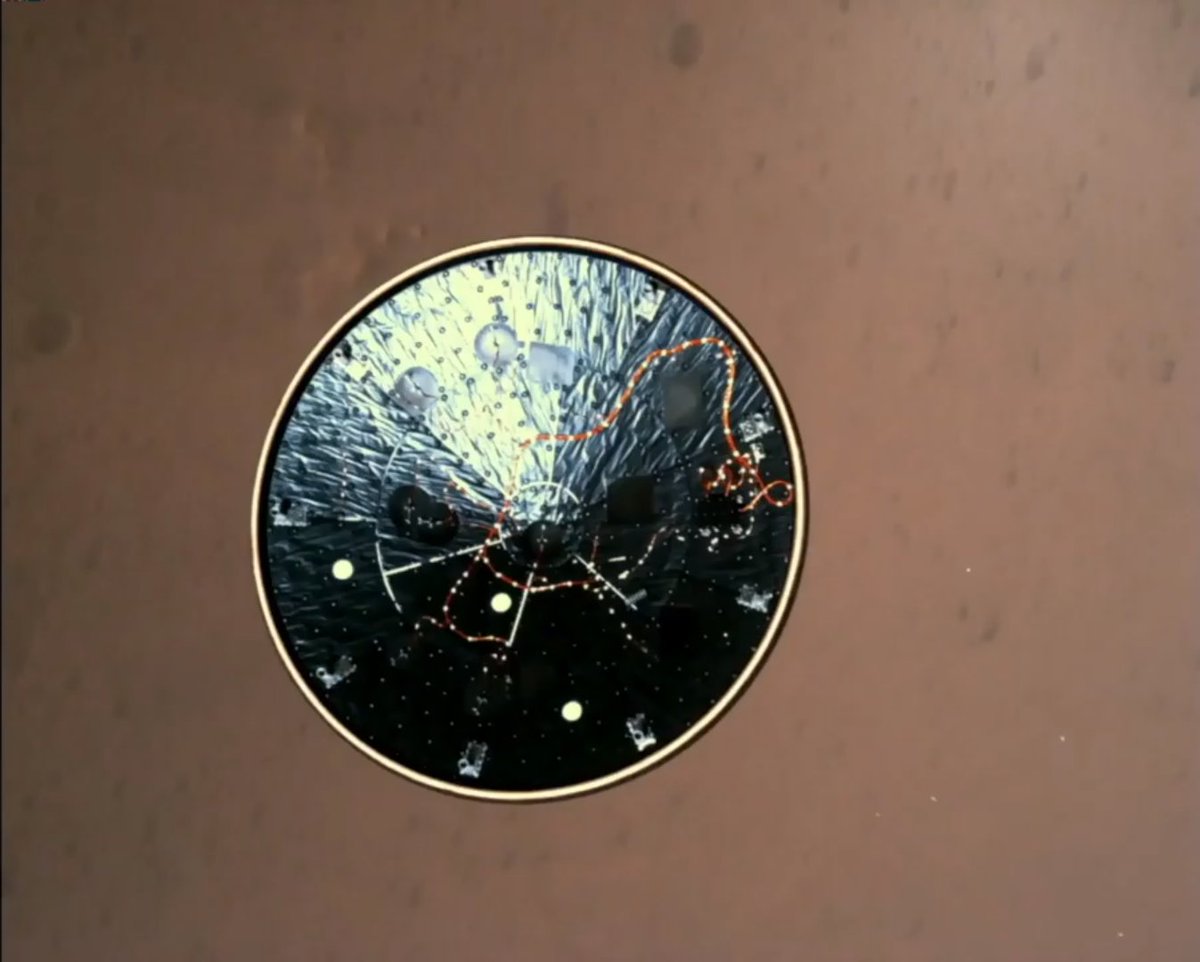
"Here we are, slowing down and stopping, straight down on the landing site. You can see the engines throttle and stop us and begin to push all that dust around us on the ground." (Rover's view down.)
Same point of view from the descent stage.
Al Chen explains the landing footage, from the rover's up-looking camera, with a view of the descent stage:
#CountdownToMars
#CountdownToMars
Justin Maki: "Over the weekend, we deployed the remote sensing mast. There's a new imaging system here, these cameras represent a pretty significant advancement. These are 20MP color cameras we use for planning and such. The first thing we did was image the surface." 

"This is one of the first photos we took, at quarter resolution. We're using these images to inspect everything around us. The next shows one towards the surface, and the 3rd out towards the South. It really is the surface of an alien world." #CountdownToMars 




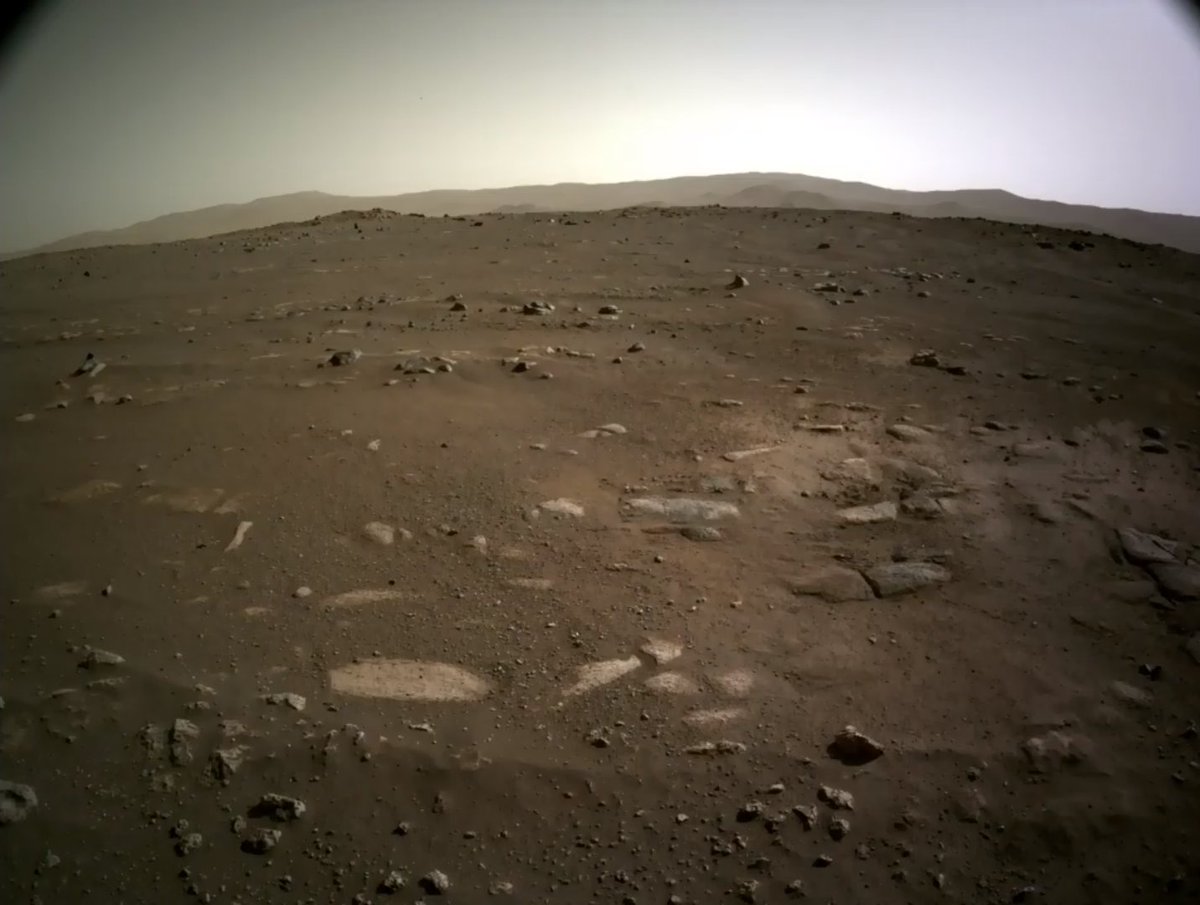
"Today we're going to be releasing a whole slew of raw images. We have thousands, already. Those are going up on the website today for people to process and download. Find your favorite picture." 

"This is just a preview of things to come, this is from the MastCam-Z. You can see where cables were cut, you can see the upper camera, you can see the calibration target. There's another target in the back for the SuperCAM. And finally, there is a little antenna, for Ingenuity." 

Jessica Samuels: "I am happy to report that Perseverance is healthy and continuing with activities as planned. To date we've executed 5,000 commands and everything comes back exactly how we've wanted it to. Things have been going well."
"We're also deploying the high-gain antenna, which is important as that increases our uplink capacity. Additionally, we have established a strong communication link with all of our orbiters and partners, MRO, MAVEN, TGO, and Odyssey. We thank those teams."
"The remote sensing mast's motion checks were nominal and as expected. All instruments are performing nominally. We can't wait to continue to use this payload suite. Our backup computer was turned on yesterday in preparation for our flight software transition."
"Looking ahead, we are excited to be on the surface flight software. Much more capabilities for the surface mission. Will take a few days to transition. Once we're on that it'll allow further checkouts and deploying the robotic arm and the turret." 

"You can see that we have the descent stage, parachute, and heatshield. The descent stage is ~700m away, parachute 1.2 km, heatshield 1.5 km. Very excited we can see all of these different components. And HiRISE was able to capture EDL from their perspective." #CountdownToMars 



Gruel: "This is the microphone that was part of the EDL system. When the EDL cam system was envisioned it was just a bunch of cameras. We got another call talking to HQ, asking, "could we possibly put a microphone as part of our system?" 

"We had a tour and this girl came up to me and told me words I'd never forget. She said she couldn't wait for the audio. I asked her why and she said her sister was visually impaired and couldn't see the photos - that stuck with me and we tried to make it work."
"I wish I had her name and could reach out to her. I do have something special here. Close your eyes, and imagine yourself sitting on the surface of Mars."
And now, without the rover noise. #CountdownToMars
Ken Wiliford: "As we get closer, our view of Mars is more coherent. Here you can see a beautiful perspective on the Jezero delta. A new perspective on our landing site as well. Now to put all of this in context, handing it over to Zurbuchen." 





Dr. Zurbuchen: "What we have seen here is nothing short of amazing. We took a big leap. Not just at JPL or at NASA, but at humanity. It was a leap enabled by work for years."
"The human aspect of exploration is every reason why we can do things and how we do things. We want to make sure everyone on Earth can feel what it's like to be on Mars and explore other worlds." 

"This journey is just the beginning. Imagine Perseverance sitting on a hill, watching another mission land. Imagine the first entry, descent, and landing of a real crew on Mars. These will be enabled by women and men working together in diverse teams." #CountdownToMars
"We've been on this journey for quite a while. I want to show this image of the Pathfinder/Sojourner rover, designed for 7 sols, lasted for over 80. A surprising amount of science. Now Perseverance is the size of a small car." 
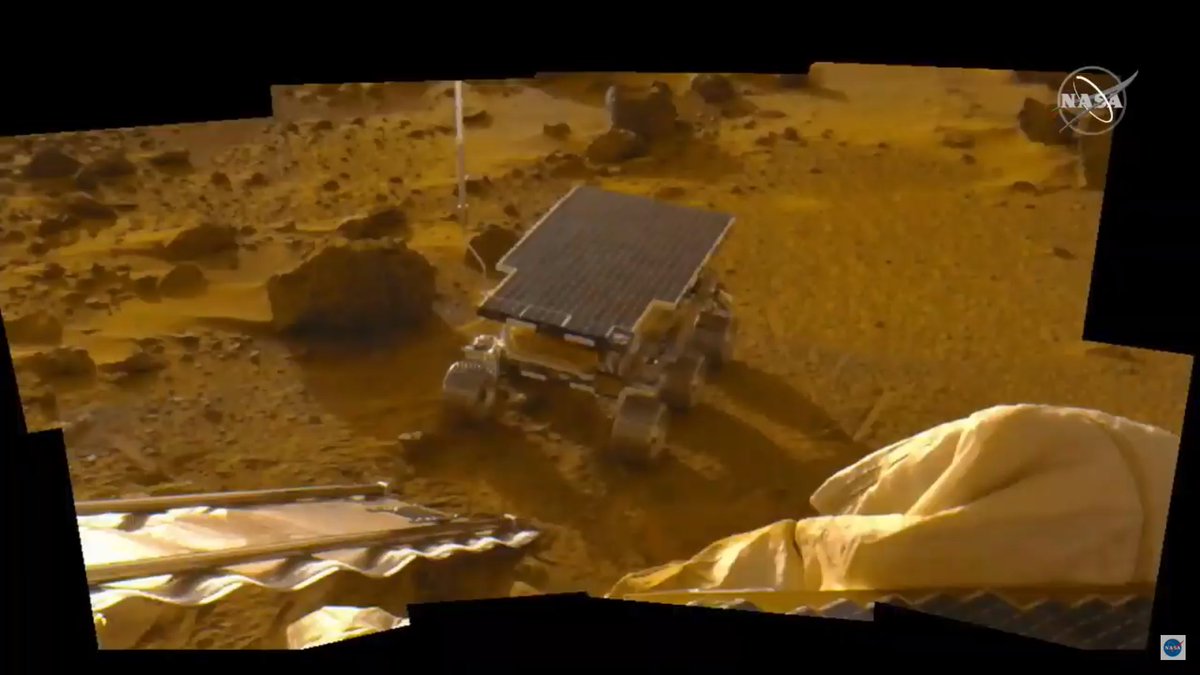
"And here's a picture of the sample caching system. The system that will connect this mission to the sample return mission. This, my friends, is a moment in NASA's history in which what we can see and learn makes it feel like all of us are coming together. Our future is bright." 
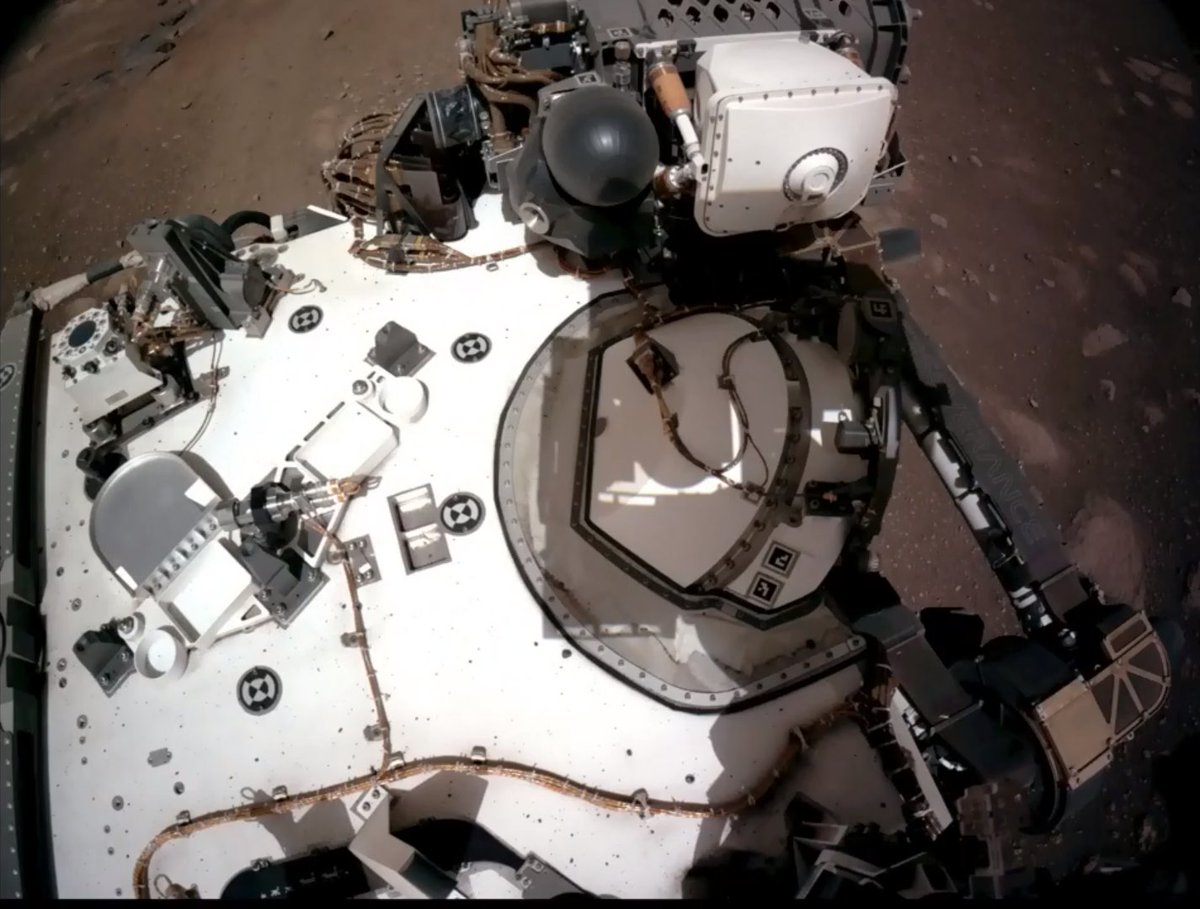
"We will return to Mars, and study these samples at home. I am so proud of this team, literally thousands at JPL and NASA. And I've heard the raw image pipeline is opening up - go and download, process those photos. Who will make the first Mars music?"
"I am so grateful, Matt, for the suggestion of the cameras. This is just a start. We have science in action. Stay with us, there is much more amazement to come."
QA starting now.
@cbs_spacenews: "Other than the loose spring, is there anything at all that looked off-nominal? It looked almost textbook."
Chen: "We did have a pretty clean run. There were a couple bits of the parachute lid that came off. You can see a chunk (the radome) that came off."
Chen: "We did have a pretty clean run. There were a couple bits of the parachute lid that came off. You can see a chunk (the radome) that came off."
"We hoped it wouldn't, but that was a risk we knew. But I think in general, you're right, it behaved as expected. It did what it had to do. And a big shout out to the terrain-relative navigation system. The system worked great."
@AssociatedPress: "Did the JPL team get to see snippets of the video, or did you have to wait for it to be stitched together? Why do you think the mic didn't work?"
Wallace: "I had trouble leaving the area this week just because I was waiting for every bit of information."
Wallace: "I had trouble leaving the area this week just because I was waiting for every bit of information."
"This is the first time, as engineers, we've had a chance to see what we've designed. It's hard to express how emotional and exciting this was."
Maki: "When we get the first images, the test images never look as good as the real thing. Moment you get it from Mars is electric."
Maki: "When we get the first images, the test images never look as good as the real thing. Moment you get it from Mars is electric."
"We go through months and months of testing, the images don't really look that great on Earth, people get skeptical, so it's amazing to get these images from Mars now."
Gruel: "Thursday and Friday, my phone started to go off, I got facetimes from people in the MSA."
Gruel: "Thursday and Friday, my phone started to go off, I got facetimes from people in the MSA."
"They said, 'you gotta see this reaction!' and people were jumping up and down and giddy. There was a lot of effort here, and to reward and pay it back made me super happy. All the work and dedication had come in. We were excited about what we captured. I won't forget it."
"As for the microphone, we think there was a communication error between the digitizer and the computer. We're not sure why, it could've just been an overload, we were quickly able to determine there wasn't a hardware issue. It's unfortunate that happened in EDL."
@wapodavenport: "Can you talk a bit about the cameras used to record the video? What goes into designing a camera to sustain that?"
Gruel: "The cameras were minimally modified. This was not designed for Mars. You can purchase it on the Internet. We added some bonding and.."
Gruel: "The cameras were minimally modified. This was not designed for Mars. You can purchase it on the Internet. We added some bonding and.."
"And we had to swap some pieces in the inside where they could outgas material in space and mess things up. It was not specifically designed for space, it was off-the-shelf."
@thesheetztweetz: "I'm curious what it's like seeing the skycrane work, and how seeing the landing informs future missions, including one day astronauts."
Wallace: "This is a thrill of a lifetime, for all of us contributing. I remember when we first briefed this system."
Wallace: "This is a thrill of a lifetime, for all of us contributing. I remember when we first briefed this system."
"We were talking about supersonic parachutes, skycranes, lowering it down, and people looked at us and thought we were insane. It wasn't easy to build or test, but it was something truly designed to interact with the uncertainties thrown at you. It doesn't get better than this."
Chen: "It's amazing to see it finally in action. We knew it worked once but we weren't sure it'd work again. Seeing it do so is impressive. And there's already some things we learned - the interaction of the rockets with the ground, that's super useful. The parachute too."
"Our parachute cameras are 75 fps - it happens in less than a second but you can watch all of that. Future missions are likely going to use parachutes and rockets."
@nytimes: "How did the 30 GB of data come back, and what data rate was it?"
Samuels: "We start with a lower rate, 2,000/8,000 kbit/s, but then we do an adaptive data rate where we do beyond 8 Mbit/s. That's relayed from the orbiters."
Samuels: "We start with a lower rate, 2,000/8,000 kbit/s, but then we do an adaptive data rate where we do beyond 8 Mbit/s. That's relayed from the orbiters."
Maki: "When the orbiters fly overhead, we get 500-900 Mbit per pass, and we've had ~5-10 passes so far."
Samuels: "Some passes have been 80-100, some have been 700+. It's variable per orbiter."
Maki: "We didn't mention it, but we're also using commercial computers too."
Samuels: "Some passes have been 80-100, some have been 700+. It's variable per orbiter."
Maki: "We didn't mention it, but we're also using commercial computers too."
"We're running an intel computer with Linux. We compressed the video with ffmpeg. Thank you to the open source community!"
Wallace: "And just a thank you to the teams from the other satellites, Odyssey, which is old, MAVEN, a Goddard spacecraft, and TGO, a European satellite. Thank you to those teams."
@SpaceNews_Inc: "What do you see the EDL microphone, now that it's working, being used for?"
Wallace: "Right now it's not a priority, but we could listen to audio files of an actuator, to evaluate the health of it. We could get a snapshot today and a snapshot in the future."
Wallace: "Right now it's not a priority, but we could listen to audio files of an actuator, to evaluate the health of it. We could get a snapshot today and a snapshot in the future."
"With that said, the microphone in the EDL system is off the shelf hardware. It's not designed to live on Mars. Those cold cycles will significantly limit the life of these devices. The SuperCam microphone might continue to work - it can last longer."
"We're always surprised by how rugged and robust some of our items are."
Samuels: "That application was something we tested, and even though this is an EDL capability, we carried that to our surface software too. We're open and ready to use it."
Samuels: "That application was something we tested, and even though this is an EDL capability, we carried that to our surface software too. We're open and ready to use it."
Maki: "We got a request to listen to the microphones from the instrument teams. MOXIE wants to hear their compressors. This might become standard on all rovers."
Wallace: "I hope it does survive long enough for us to hear the rovers crush over the ground, to hear the first sample, I'm hopeful our little microphones will hang in there."
@ScienceNews: "The video is amazing and looks a lot like the animations. How will you distinguish those so it's clear to people?"
Chen: "We should label it very clearly. It's clear to a lot of us but the animations are very good. We should label it going forward."
Chen: "We should label it very clearly. It's clear to a lot of us but the animations are very good. We should label it going forward."
"It's a great problem to have!"
Maki: "It's real, it's real. We thought it wasn't too. This is actually real stuff and that's why it's so exciting. For those of you that watch the videos, I watch at quarter speed or even slower. There's so much detail there."
Maki: "It's real, it's real. We thought it wasn't too. This is actually real stuff and that's why it's so exciting. For those of you that watch the videos, I watch at quarter speed or even slower. There's so much detail there."
Chen: "When we came up with the animations for MSL, we had a discussion about the plumes, and that they were clear and you wouldn't see them in real life. But we thought people would expect to see them so we took some artistic license. Maybe our future animations will."
Social media Q: "We can see dirt and rocks inside the wheels. Is this expected and could it be an issue?"
Samuels: "This isn't uncommon. You'll also notice on the deck we had some debris on the rover. We design our systems for these conditions."
Samuels: "This isn't uncommon. You'll also notice on the deck we had some debris on the rover. We design our systems for these conditions."
@SciGuySpace: "Chen mentioned the dust earlier and how much was kicked up. When you're talking about human missions, it's much larger. What does seeing this dust tell us about landing much larger spacecraft on Mars?"
Chen: "As far as I know, there's no pads, or barges, on Mars."
Chen: "As far as I know, there's no pads, or barges, on Mars."
"We're going to have to deal with this plume-ground interaction. It's really difficult to get right. You don't know exactly where you're going and where you're coming down. This is a big challenge for us going forward and collecting this information here is very useful."
@joroulette: "Earlier it was mentioned scientists are already pouring through the thousands of images. What about the rock surfaces you've seen so far? What stands out?"
Williford: "We're noticing the different colors that we see, textures, and tones."
Williford: "We're noticing the different colors that we see, textures, and tones."
"A lot of the rocks that are labeled as 'light rocks' have rough textures, but large boulders seem to be smoother. That could mean something about the composition of the rocks. These light rocks may be dark on the inside."
"One of the possibilities for those holes is they are volcanic rock. We're not sure and we don't want to lock in on limited data. We're getting views of the delta front now also putting us on cloud nine."
@AstronomyMag: "Can you speak to the performance of the landing system? What it was thinking, how it made its decisions? Can you see the improvement?"
Chen: "The landing vision system is part of the TRN system. We took tons of images, matched what we saw with the map."
Chen: "The landing vision system is part of the TRN system. We took tons of images, matched what we saw with the map."
"It was almost perfect, better than field tests and sims. We only missed the targeted pixel by about 5 meters. Given how well the vision system performed, we only missed by 5m. That was great and we showed this system can do what we wanted it to do."
Social Media Q: "How does the processing power of the on-board computer compare to a smartphone?"
Wallace: "In space, we have to build things we know will work. Space is a hostile environment and Mars is even worse. We need systems capable of dealing with it."
Wallace: "In space, we have to build things we know will work. Space is a hostile environment and Mars is even worse. We need systems capable of dealing with it."
"We have a tendency to use systems that have been around for a while that are well shaken out. We're using the same computer we used on Curiosity because we know it worked. This is a computer that you would've found 20 years ago."
"Having said that, these EDL cameras are off-the-shelf, state of the art, new technology. It's always great for us to bring that kind of tech into our systems. It's a very powerful way to multiply our functionality. This is a great example of being able to use new technology."
Media Q, from an 11 year old: "What advice would you give to a budding planetary scientist who wants to work on Mars Sample Return?"
@Dr_ThomasZ: "I think about that a lot. There is no better time to start that career. Start playing with the data. And yes, go to school."
@Dr_ThomasZ: "I think about that a lot. There is no better time to start that career. Start playing with the data. And yes, go to school."
"But the other thing, we're putting all this data out, do your own research and go play with it. Find others who are just as excited as you are, and I'm sure, soon enough, we'll have you on our teams in the future."
Reporter Q: "Did InSight hear Perseverance landing?"
General reply appears to be "we don't know".
General reply appears to be "we don't know".
Times of London: "I get a lot of readers asking what's the point? Can you tell us?"
@Dr_ThomasZ: "When we do that at NASA, I just want to let everyone know, the money we're spending most money on is Earth. The place where we are."
@Dr_ThomasZ: "When we do that at NASA, I just want to let everyone know, the money we're spending most money on is Earth. The place where we are."
"I am excited about the future of our exploration. Exploration is so much broader than what is useful right now. The questions that have driven humanity - in many ways - are what we're really about. We really want to move forward with what we know."
"There is a second reason, it is truly secondary, but I would like to mention it anyways. The tech we build is extremely useful. Perhaps, today, whoever asked that question is driving around in their car with a GPS system, or the weather forecast, when we built the satellite."
Wallace: "How can we not explore? It's just who we are. You can't stop us as a species from exploring. It's why we're at the top. We're curious. We want to go to places we haven't been. We want to answer questions. We find questions we don't know even need to be asked."
"It's part of who we are. It opens new horizons, new frontiers. It inspires kids. As Thomas mentioned, all the academic programs paying attention here. That is important for us. I think that's the best I can do to answer that question."
@exploreplanets: "My question for Wiliford, getting these images from the surface of Mars, does this make you think of the potential of doing this on a regular basis? From balloons or helicopter?"
Williford: "Everything I'm thinking of is potential."
Williford: "Everything I'm thinking of is potential."
"We're on the surface and it's real. The potential is astounding. Katie Stack and I were texting and we were excited like kids looking at these pictures, and the potential of it all strikes me more than anything. So far to go, so much to learn. I could not be more grateful."
@Free_Space: "Have you made any progress homing in on a site for the heli flight demos?"
Samuels: "The team has started to evaluate, using some images we've received from EDL. We are fortunate to have landed in a potential spot for that. The team is still evaluating."
Samuels: "The team has started to evaluate, using some images we've received from EDL. We are fortunate to have landed in a potential spot for that. The team is still evaluating."
"The team is looking forward to additional imaging from the MastCam-Z and future data. The site is not locked in yet. Whether here or a few hundred meters away."
Social Media Q: "Did this ever feel impossible?"
Wallace: "Last March, when the COVID pandemic struck, we just shipped the spacecraft down to Kennedy, Gruel was launch and ops manager, and he and his deputy were responsible for testing it. So it struck about a year ago."
Wallace: "Last March, when the COVID pandemic struck, we just shipped the spacecraft down to Kennedy, Gruel was launch and ops manager, and he and his deputy were responsible for testing it. So it struck about a year ago."
"We were constantly on the phone figuring out how to react and respond. We didn't have much margin or time. We were figuring out things as quickly as we could. The focus shifted from staying on schedule to keeping people safe. I wasn't sure. That could have been it."
"We got tremendous support from JPL, HQ, SMD, and we got through it, but that was the existential moment for me. That time right there, the first 3-6 weeks after COVID hit hard."
Maki: "We spend 7 or 8 years, building, testing, making sure it'll work, and you know, it all comes down to one moment. You really want that to work. You try everything you can do to make sure it'll work. We're open-minded about what could go wrong and cover all our bases."
"JPL is a gem of a place because we built a culture of questioning what could go wrong while hoping for the best."
Samuels: "We invite that feedback from each other and the reviewers. We push ourselves to meet those challenges. You want it all to work."
Samuels: "We invite that feedback from each other and the reviewers. We push ourselves to meet those challenges. You want it all to work."
Irish TV: "There's no doubt about the 12 year old asking the best question. Could someone talk to the traversability of the canyon? Could you go there, or would you have to go northeast? Can you move quickly?"
Samuels: "We have a lot of time in different conditions to evaluate."
Samuels: "We have a lot of time in different conditions to evaluate."
"What we did on this mission was enhance the traversability capability here with enhanced autonomous capability. We have many more images still to asses in terms of evaluating our path forward, but I'll let Ken speak to the areas we're pursuing."
Williford: "Great question and our major focus right now. First of all, we're so extraordinarily happy about exactly where we've put down. We ended up on a major geologic feature between two different units. There's this undulating feature that's an obvious line."
"It's a major feature we hoped to explore in this mission and presents a big mystery. What is that crater floor made of? Are there igneous, sedimentary rocks, or both? We're currently leaning towards exploring that contact which leads us to the second option."
@Reuters: "Regarding EDL video and audio, is it correct to say this is the first moving footage of a spacecraft showing its descent and landing of the surface of another world? Is this the first sound recording ever made on another celestial object?"
Wallace: "Apollo aside, this is the first time we've seen ourselves landing on another planet. For sound, this is the first planetary sound recorded."
Maki: "The InSight lander has a seismometer that they could measure signals rendered as audio. That could be another one."
Maki: "The InSight lander has a seismometer that they could measure signals rendered as audio. That could be another one."
Maki: "MSL did have a descent imager that did video - 3.5 fps, so that was slower. We also did timelapse videos of deployment on InSight and then for Pathfinder of the rover on the surface. This is the best video of any of them. We can say that definitively."
That is all for today. There is a Reddit AMA scheduled for 1 p.m. Pacific (in 15 minutes).
For raw images, visit: mars.nasa.gov/mars2020/multi…
For updates, follow @NASAPersevere.
For raw images, visit: mars.nasa.gov/mars2020/multi…
For updates, follow @NASAPersevere.
Finally, the full video of Perseverance landing on Mars, the first of its kind ever recorded:
Unrolled thread of today's #Perseverance press briefing: threadreaderapp.com/thread/1363926…
#CountdownToMars #Mars2020
#CountdownToMars #Mars2020
• • •
Missing some Tweet in this thread? You can try to
force a refresh



